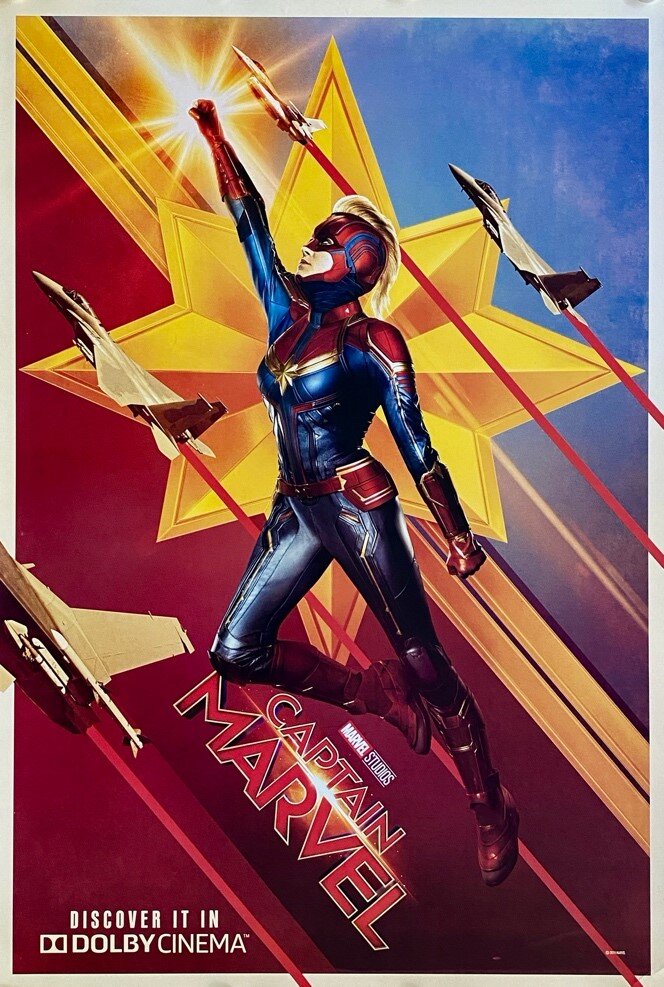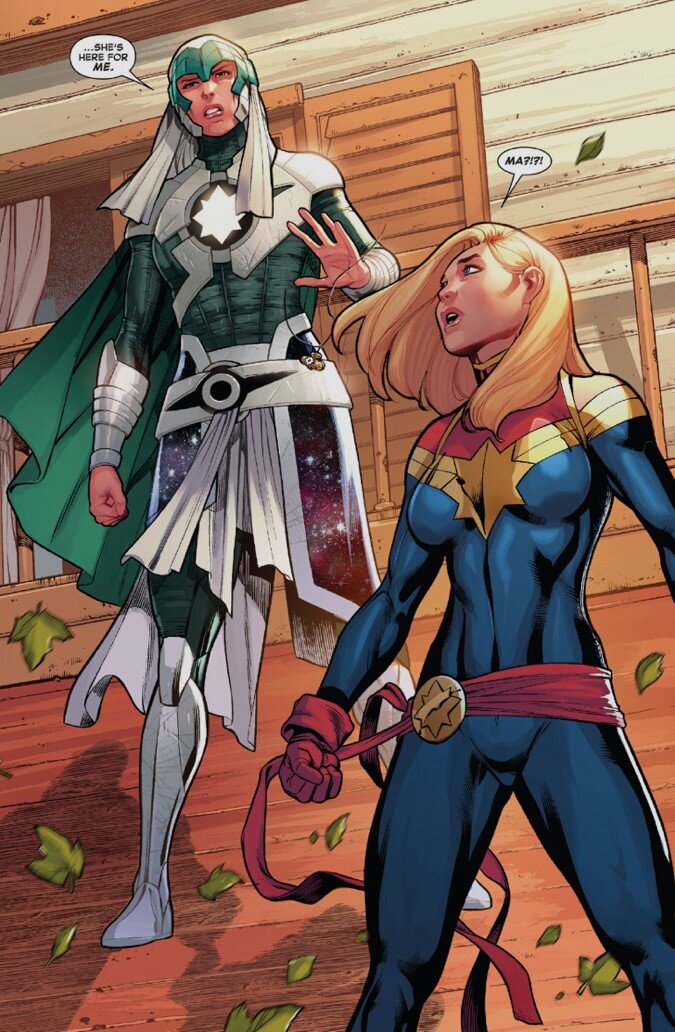Captain Marvel: Between Comics and Film
What’s in a flerken?
Having watched Goose regurgitate the tesseract at the post-credit close of Captain Marvel (Anna Boden & Ryan Fleck, 2019), I immediately wanted to know: what’s in a flerken? Finding my answer meant looking to the comics, in particular the reboots of Captain Marvel in print by both Kelly Sue DeConnick and Margaret Stohl. I have to admit to not learning much more about flerkens, alien creatures which appear to resemble ginger cats, but DeConnick and Stohl’s revisionings did give me a lot more insight into Carol Danvers/Captain Marvel as a contemporary woman who struggles with her history. Just as a flerken consists of unique ‘pocket dimensions’ inside their bodies that allow them to swallow (and safeguard) large objects, the comics add further dimensions to Carol’s story through transmedial storytelling. Reading these changed my engagement with the 2019 film adaptation of Captain Marvel. In the film (Fig. 1), Carol Danvers/Captain Marvel’s history is central, and bringing it to light sits alongside the revelation of her power. Indeed, much of the pre-release publicity around Captain Marvel, the first MCU film lead by a female superhero, pushed the message that the film is the origin story of the ‘world’s mightiest hero,’ a woman coming to terms with who and what she is. In classic Marvel science-fiction and fantasy mode, the three official trailers showed off terrestrial fights, action in space, and made the question of her history explicit: ‘would you like to know what you really are?’ The answer given in Captain Marvel is, though, only part of the story. As this blog post argues, the comics deepen Carol Danvers history, and their transmedial dimensions add complexity and relatability to her as both a ‘real-world’ and fantasy hero.
The links between Captain Marvel and its comics were already flagged in pre-release publicity. Directors Anna Boden and Ryan Fleck, known for their work on smaller budget more independent films such as Half Nelson (2006) and Sugar (2008), were signed up to direct Captain Marvel by the Marvel Studio because of their ability to ‘create a singular character journey.’ When talking about how they created their Carol Danvers/Captain Marvel (played by Brie Larson), Boden and Fleck name check Kelly Sue DeConnick’s reboot of the Captain Marvel comics. These were published initially between 2012-2014, and released in a three volume series Captain Marvel: Earth’s Mightiest Hero (2016-2017). Prior to the DeConnick reboot, Captain Marvel had been renamed several times (Ms. Marvel, Binary, Warbird), and transitioned from a love-interest to various degrees of side-kick across a range of comic series. For her reboot of the Captain Marvel comics, DeConnick re-imagined Carol Danvers as an ace air force pilot who, caught in a blast of alien (Kree) technology, gained superpowers and the status of a superhero in her own right. This re-imagining directly informs the characterization of Carol Danvers in the film.
Captain Marvel uses two converging narrative arcs to introduce Boden and Fleck’s version of the earth’s mightiest hero. In one she regains her memory of her past and in the other accesses the full potential of her powers. Building on DeConnick’s reboot, Carol Danvers is a pilot who gradually recalls her human origins as she again makes contact with lost friends. As her backstory fills, we learn she grew up in an environment where girls were discouraged from competing with boys, she broke gender conventions by becoming a pilot, and went on to forge a friendship with Maria Rambeau (Lashana Lynch) and her mentor Wendy Lawson (Annette Bening) (Fig. 2). The details of this human-based history are told through flashbacks, and completed once Carol visits Maria and her young daughter Monica.[1] Before these memories emerge, we are first introduced to Captain Marvel exclusively in her Kree persona, Vers. She is a warrior constantly told that she lacks impulse control, and who must conform to Kree code to succeed. The parallels in the controlling prohibitions between these two arcs are clear, and their convergence adds power once Carol begins to break free.
The two story arcs in the film are complemented and expanded by DeConnick’s comic series Captain Marvel: Earth Mightiest Hero, and also The Mighty Captain Marvel and The Life of Captain Marvel series by Margaret Stohl. In Captain Marvel: Earth’s Mightiest Hero, issues 1-6, DeConnick creates a fantastical time-travelling story about Carol and a pilot called Helen Cobb. The latter’s story draws on the history of women in American aviation through the 1940s to the 1960s, into which DeConnick threads the origin story of Carol’s power and Kree technology. Helen (and her team of women aviators) strive to overcome a system that prevents her from competing with male pilots. This has an echo in the film version, since the Carol of Captain Marvel is not allowed to fly the same aircraft as men and she instead flies tests for Wendy Lawson. While Wendy passes for human, she is in fact Mar-Vell, a Kree with some attitude. The complex time-travelling tale that features in Captain Marvel: Earth’s Mightiest Hero adds a transmedial heft to Carol’s backstory as a pilot, while Annette Bening’s look in Captain Marvel echoes that of the mature Helen Cobb (Fig. 3).
Margaret Stohl too revisits Carol’s origin story in her reboot, but this time goes back to her childhood years, something only glimpsed in Captain Marvel. In the latter, we have hints towards a difficult relationship with her father and see several scenes of a young Carol failing in activities, crashing into bales of hay in a go cart track, missing a pitch in baseball, unable to rope climb to the top as an air force recruit. Each time she is goaded with comments and prohibitions about not being good enough. In the series Captain Marvel: Alien Nation (collected edition 2017), Stohl echoes the origin story already found in DeConnick’s comics. Interspersed with an Alpha Team adventure, Carol has nightmares and therapy and we learn her father refused to support her going to university but did support one of his sons. With The Life of Captain Marvel (collected edition 2019) Stohl dives more deeply into Carol’s backstory, combining ‘real world’ issues with science-fiction fantasy. Her father (Joe) is characterised as violent towards his children and also an alcoholic. The twist in Stohl’s story is that Carol’s mother is a Kree warrior Mari-Ell, and the comic tells the story of how she came to Earth, fell in love with Joe, which lead her to be denounced as a traitor. The revelation that ‘Ma’ is an alien occurs because Carol accidentally activates a tracker device and a Kree enforcer is sent to execute Mari-Ell. Before this revelation, Carol confronts her mother about why she put up with her now long dead father’s behaviour and allowed him to treat Carol and her two brothers in the way he did (Fig. 4).
The pressure behind this question only increases when Ma is revealed to be a Kree warrior of the highest order (Fig. 5). Though Stohl doesn’t offer a deep answer to the question, she shows Carol, her remaining brother and their mother, at the start of a process of understanding as they begin coming to terms with their complicated family history.
The backstory of a violent father doesn’t explicitly feature in the film version of Captain Marvel. Nor is there any mention of Carol’s Kree mother, though at the point of The Life of Captain Marvel’s (issue#4) release in 2018 there was speculation on whether the new origin story would be included in the movie. There is, however, the montage sequence showing the younger Carol’s responses to being told she is not good enough. Across a series of images, Carol gets up off the sand, puts her bicycle upright, takes aim at another pitch, readies herself to try again at go karting or rope climbing. Each set of images echoes the same movement as she gets up and sets herself yet again against adversity, refusing the prohibitions she experienced in her childhood. The final denouement between Carol and Yon-Rogg (Jude Law) builds on this and brings together the converging arcs of memory and power regained when she says: ‘I have nothing to prove to you’.
In Captain Marvel, the converging arcs of Carol regaining her memory and accessing her full powers strike me as both a strength and weakness in the film. The scenes between Carol and Wendy and Carol and Maria have a depth that suggests so much more than is given in the film. This can leave a sense of superficiality, that something is missing. A strength of this converging arc, though, is how it opens up fan speculation about possibilities (Fig. 6). Indeed, there is much interest in whether or not Carol and Maria have been lovers, a view abetted by Brie Larson’s comments “This is the love of the movie. This is the love found again.”
The comics offer another opening for fans and other interested viewers where they can find ‘the something missing’. As I mentioned at the beginning, I turned to the comics to find out more about flerkens. To briefly digress, DeConnick features Chewie (as the flerken is known in the comics) in a story alongside the Guardians of the Galaxy. And, just as Talos is wary of Goose in Captain Marvel, Rocket remonstrates with Carol that Chewie is a vicious killer, a living gateway into pocket dimensions, can lay eggs producing 117 flerkittens, and travel across space by a kind of regurgative process. Coming back to Carol’s story, like a flerken what we see in Captain Marvel is only part of the picture and the transmedial story which flows between the comics and film adds extra dimensions to her history. For Marvel aficionados there is nothing novel in this point: the comics have always provided a wider landscape in which science fiction and fantasy adventures can be told. DeConnick and Stohl too tell stories featuring adventures on earth or in space, but in combination with harder edged narratives of Carol’s family history.
Reading across and between the films and comics is part and parcel of engaging with the Marvel universe. For me, the DeConnick and Stohl reboots add depth to Carol’s story as her push back against all the put downs accumulates across both the comics and film. And, sure, this means she’s flawed and troubled, but having glimpsed the reason for why she stands up and fights back, we know some of her experiences are relatable. As part of the Marvel franchise, Captain Marvel is clearly made with financial success in mind, and, taking a cynical view, its feminism has more to do with diversifying the audience than any real investment in equality. But, if this film gives women a space to celebrate rather than prove themselves, then ‘higher, further, faster, baby.’
**Article published: August 21, 2020**
Notes
[1] As created in the comic universe by Roger Stern, the character Monica Rambeau is a superhero figure with many aliases including Captain Marvel, Photon and Spectrum. She features in DeConnick’s Captain Marvel: Earth Mightiest Hero (issue # 7).
Biography
Aylish Wood is Professor of Animation and Film Studies at the University of Kent. She has published articles in Screen, New Review of Film and Video, Journal of Film and Video, Games and Culture, Film Criticism and animation: an interdisciplinary journal. Her books include Technoscience in Contemporary American Film (2002); Digital Encounters (2007) and, Software, Animation and the Moving Image: What’s in the Box (2014). She is completing a book on animation, games and software and planning on reading a lot more comics.






